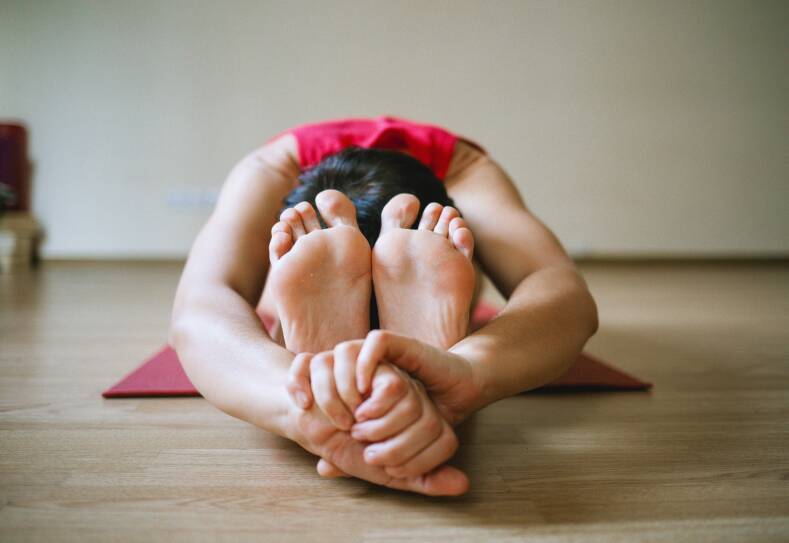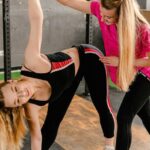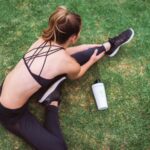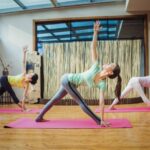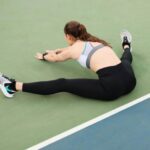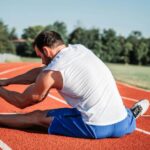Attaining flexibility is a common health and fitness goal for many individuals, especially for beginners taking their first steps into improving their overall well-being. Flexibility, the ability of joints to move through their full range of motion, is an essential component of an active lifestyle. It not only enhances movement but also assists in preventing injuries, reducing muscle soreness, and improving posture. For those just starting out, setting realistic flexibility goals and gradually incorporating stretching exercises into a fitness routine are key steps towards achieving long-term improvements in flexibility.
Beginning a flexibility journey involves understanding the balance between different types of stretching and the body’s natural limits. Static stretching, where individuals hold a single position for a period to lengthen the muscles, is often recommended post-workout to aid in recovery. Dynamic stretching, involving movement-based stretches that prepare the muscles for activity, is beneficial prior to exercising. Beginners should aim for consistency, starting with shorter sessions of stretching and progressively increasing the duration and complexity as their flexibility improves.
It’s important for beginners to approach their flexibility goals with patience, recognizing that improvements occur over time. Regular practice is more beneficial than the occasional intense session. Integrating flexibility training into a weekly routine, ideally three days a week, can help create a foundation for continued progress. By focusing on breath work and proper technique, beginners can safely improve their flexibility, enjoy greater ease of movement, and lay the groundwork for a healthier, more active lifestyle.
Understanding Flexibility and Its Importance
Flexibility is a fundamental aspect of fitness, involving a person’s ability to move their joints through a complete range of motion. This section explores what flexibility is, its benefits, and how it contributes to injury prevention.
Defining Flexibility
Flexibility refers to the capacity of the joints to move freely through their complete range of motion. This capability is supported by the elasticity and length of the muscles and connective tissues surrounding the joints. An individual’s flexibility level is a measure of how easily they can perform movements without restriction.
Benefits of Improved Flexibility
- Health Enhancement: Regular flexibility exercises enhance blood circulation, ensuring that joints are well-lubricated and nourished, which can lead to better overall health.
- Functional Advantages: With greater flexibility, daily activities become easier and more efficient, as the body can move more freely and with less discomfort.
Role of Flexibility in Preventing Injury
Improved flexibility contributes significantly to injury prevention. By allowing the joints to move more freely, the risk of musculoskeletal injuries is reduced. Flexible muscles and joints can absorb movement impact better, which diminishes the likelihood of strains and sprains. This preventative aspect is crucial for both daily living and for individuals engaged in physical activities.
Setting Realistic Flexibility Goals
When embarking on a journey to enhance flexibility, beginners should focus on setting achievable goals, embracing consistent practice, and tracking improvement.
Evaluating Your Current Flexibility Level
A beginner must initially assess their current flexibility to establish a baseline. This can involve tests such as reaching for the toes or measuring the range of motion in various joints. Documenting the starting point allows for tailored goal setting and tracking enhancement over time. For instance:
- Toe Touch Test: Noting the distance between fingers and toes.
- Sit and Reach Test: Measuring how far one can reach past their feet while seated.
Creating a Personalized Flexibility Plan
Once a beginner understands their current level, they can create a personalized flexibility plan. This plan might include routines such as:
- Stretching exercises, like hamstring stretches or shoulder rolls, to be performed daily.
- Yoga sessions twice per week, increasing in complexity as one advances.
- A flexibility challenge where one commits to a consistent routine for a set period, such as 30 days.
Each session should start with a warm-up and end with a cool down to prevent injury and aid in muscle recovery.
Progress Tracking and Adjustments
It is crucial to track progress towards the set flexibility goals. Beginners should celebrate small victories to stay motivated. For instance, recording improvements every two weeks can demonstrate increased range of motion or the ability to perform new stretches. If a goal seems too challenging, adjustments may be necessary to avoid discouragement. The tracking method can be as simple as a chart:
| Week | Toe Touch Progress | Shoulder Flexibility | Notes |
|---|---|---|---|
| 1 | -5 inches | 45 degrees | Initial assessment |
| 3 | -3 inches | 50 degrees | Slight improvement, keep practicing |
| 5 | -2 inches | 55 degrees | Consistent progress |
Adapting the flexibility plan based on these observations enables a beginner to maintain a consistency that is key for ongoing improvement.
Fundamentals of Stretching Techniques
Before delving into specific stretching practices, it is crucial to understand that stretching should help improve flexibility and range of motion while minimizing the risk of injury. The cornerstone of any stretching routine incorporates dynamic and static stretches, tied together with proper breathing techniques to enhance performance and reduce discomfort.
Dynamic Stretching for Beginners
Dynamic stretching involves active movements that gently propel muscles in and out of stretch. Perfect for warming up, they prepare the body for physical activity by increasing heart rate and blood flow. They typically include motion, such as leg swings or walking lunges, and should be performed for about 5-10 repetitions on each side. These stretches should cause no pain, only a feeling of muscle activation and lengthening.
- Example Stretches:
- Leg Swings (front-to-back and side-to-side)
- Arm Circles
- Walking Lunges
Static Stretching Essentials
Static stretching, on the other hand, involves holding a stretch without movement, usually for 15 to 30 seconds. These stretches are beneficial after exercise as they help to cool down the body and improve overall flexibility. Each stretch should be held at a point of mild tension or slight discomfort to ensure muscles are being effectively lengthened.
- Key Points:
- Hold each stretch for 15 to 30 seconds
- Avoid bouncing or jerking movements
- Important: Do not push to the point of pain
Breath Work in Stretching
Incorporating proper breathing is a fundamental component of effective stretching. Breathing deeply helps to relax muscles, promote blood flow, and increase oxygen supply to muscle tissue. Inhale deeply before beginning a stretch, and exhale during the most challenging part of the stretch. This flow of breath assists in releasing tension and deepening the stretch, particularly during static holds, allowing for a more profound and effective stretch experience.
- Breathing Techniques:
- Inhale deeply before starting the stretch
- Exhale as you move into the deeper phase of the stretch
- Maintain a rhythmic breathing pattern throughout
Key Stretches for Fundamental Muscle Groups
To achieve overall flexibility, one must incorporate key stretches that target all the primary muscle groups. This includes the upper body, core, back, and lower body. Consistent practice of these stretches can greatly improve flexibility and range of motion.
Upper Body Stretches
For the upper body, especially the shoulders and upper back, individuals can perform stretches such as:
- Shoulder Stretch: Extend one arm across the body at shoulder height. Use the opposite hand to gently pull the extended arm closer, holding for 15-30 seconds, then switch sides.
- Tricep Stretch: Raise one arm over the head, bend the elbow to reach down towards the opposite shoulder blade. Use the other hand to gently push on the bent elbow for a deeper stretch.
Core and Back Stretching Routines
Core and back stretches focus on the muscles of the torso, including the spine:
- Cat-Cow Stretch: Begin on all fours. Alternate between arching the back upwards (Cat) and dipping it towards the floor (Cow), moving with each breath to flex and extend the spine.
- Seated Twist: Sit with legs extended. Cross one leg over the other and twist the torso towards the raised knee, holding the stretch for 30 seconds before switching sides.
Lower Body Flexibility Exercises
Stretches for the lower body should target key areas such as the hamstrings and hip flexors:
- Hamstring Stretch: Sit on the ground with one leg extended. Lean forward from the hips, reaching for the toes of the outstretched leg, keeping the knee straight.
- Hip Flexor Stretch: Kneel on one knee with the other foot in front with the knee bent. Shift your weight forward, keeping the back straight, until feeling a stretch in the front of the hip.
Incorporating Mobility Work into Daily Life
To effectively enhance flexibility, one should integrate mobility exercises into their everyday routine. This practice ensures consistent progress and helps in maintaining the motion range achieved through training.
Everyday Activities for Enhanced Mobility
Daily tasks offer ample opportunities for individuals to improve their mobility. Consider these activities to seamlessly include in a daily schedule:
- Morning Stretch: Upon waking, a series of stretches can invigorate the body. One might start with a 2-set routine of full-body stretches to promote blood flow.
- Desk Intervals: For those with sedentary jobs, setting a reminder to stand and perform light stretches every hour helps relieve tension and maintains muscle flexibility.
- Evening Walk: An evening stroll assists in decompressing the spine and hips, especially after prolonged periods of sitting or standing during the day.
Adhering to these activities daily provides consistent mobility practice without overwhelming one’s schedule.
The Role of Posture in Flexibility
Maintaining proper posture is vital in achieving optimal mobility. Key aspects to focus on include:
- Sitting Alignment: When seated, keeping the back straight and shoulders relaxed but aligned over the hips improves thoracic mobility.
- Standing Posture: While standing, aligning the ears, shoulders, hips, and ankles in a straight line reduces strain on the body.
Incorporating awareness of these postural habits helps one to move out of their comfort zone while expanding their range of motion and reducing bodily tension.
Yoga and Pilates for Improving Flexibility
Yoga and Pilates are both effective disciplines for increasing flexibility, involving a range of movements that cater to beginners and help to enhance the body’s range of motion over time.
Yoga Poses for Beginners
Downward Dog (Adho Mukha Svanasana) is a staple in yoga that targets the hamstrings and calves. It also strengthens the shoulders and can improve circulation. Beginners should aim to hold this pose for 5 breaths, gradually increasing as their flexibility improves.
- Steps:
- Begin on all fours, ensuring wrists are aligned under shoulders.
- Tuck toes, lift hips upwards, forming an inverted V-shape.
- Keep knees slightly bent if needed, and press heels towards the floor.
Cobra Pose (Bhujangasana) is a gentle backbend that stretches the chest while strengthening the spine. It’s a foundational pose for building flexibility in the back.
- Steps:
- Lie face-down, place hands under shoulders, and hug elbows back.
- Press into palms, and lift the chest off the floor, engaging the back muscles.
- Hold for a couple of breaths, then release.
Pigeon Pose (Eka Pada Rajakapotasana) is ideal for loosening tight hips, which is a common issue for beginners.
- Steps:
- Start from Downward Dog, bring the right knee forward and place it behind the right wrist.
- Extend the left leg backward, keeping it straight.
- Lower the hips, and stay upright or lean forward for a deeper stretch.
- Repeat on the other side.
Pilates Moves to Enhance Range of Motion
Pilates focuses on precise movements and correct alignment, with an emphasis on the core. However, it also includes exercises that promote flexibility throughout the body.
- The Saw: This Pilates move stretches the hamstrings and opens up the shoulders.
- Sit with legs spread wide, extend arms to the sides.
- Twist the torso towards the right leg, reaching the left hand to the right foot, and then repeat on the other side.
- Leg Circles: They enhance hip flexibility and stability, which can help with movements like the Pigeon Pose in yoga.
- Lie on your back, raise one leg up, and circle it clockwise and counterclockwise while keeping the pelvis still.
By practicing these yoga poses and Pilates moves, individuals can work towards achieving greater flexibility. It is crucial to approach these disciplines with patience, as flexibility increases with consistent practice.
Common Beginner Mistakes and How to Avoid Them
When embarking on a flexibility journey, beginners should prioritize safety and correct technique to achieve their goals without incurring injury or pain. Understanding common pitfalls can guard against setbacks and support steady progress.
Avoiding Overstretching and Injury
Do:
- Start with a warm-up: Activate muscles with light activity before stretching.
- Implement gradual progression: Increase flexibility with patience and time.
Don’t:
- Force a stretch to the point of pain: Discomfort is a warning signal.
- Neglect rest days: Muscles repair and strengthen during recovery periods.
Overstretching can lead to muscle strains and ligament sprains, increasing the risk of injury rather than improving flexibility. Beginners should seek to recognize the difference between a beneficial stretch and one that induces pain. Maintaining a consistent stretching routine at an appropriate intensity helps prevent injury and fosters long-term flexibility gains.
Correcting Misalignments
Posture Check:
- Align head and spine: Prevents neck strain and back pain.
- Keep shoulders relaxed: Reduces shoulder and upper back tension.
Balance and Symmetry:
- Address imbalances: Prevents uneven muscle development and imbalance.
- Modify stretches to fit personal needs: Tailor to correct postural deviations.
Misalignments during stretching can create or exacerbate imbalances, leading to issues such as back pain and reduced range of motion. It is essential for beginners to focus on their body alignment, ensuring that each stretch targets the intended muscles effectively and symmetrically.ław
Additional Resources and Tools for Beginners
Embarking on a flexibility journey, beginners should consider leveraging technology and equipment to aid their progress. Carefully selected apps and programs can provide structured guidance, while the right props and equipment may enhance the effectiveness of stretching sessions.
Recommended Apps and Programs
- Flexibility Apps: Beginners are advised to download apps like StretchIt or Start Stretching, which offer tailored stretching routines with visual and auditory guidance. These apps typically include a variety of programs catering to different levels of flexibility and goals.
- Online Programs: For those preferring a more structured approach, online platforms such as Glo or Gaia provide yoga and flexibility classes led by experienced instructors. They may offer targeted sessions for improving flexibility that can be performed at the gym or at home.
Using Props and Equipment
- Yoga Mats: A non-slip yoga mat is foundational for safe practice, providing cushioning and stability for various stretches and poses.
- Stretching Straps & Blocks: Tools such as straps and blocks can help maintain proper alignment and deepen stretches, especially for hard-to-reach areas.
- Foam Rollers: Incorporating foam rollers into routine can help release muscle tightness and improve blood flow, facilitating better flexibility over time.
Note: While useful, these tools should complement a well-planned flexibility routine and are most effective when used consistently and with proper technique.
